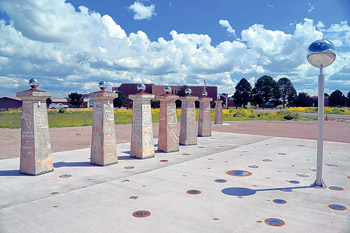 Bracewell Memorial Sundial at VLA
Photo Credit: NRAO/AUI/NSF
|
In 1961 Professor Ronald Bracewell at Stanford University created an X shaped array (called a “Chris-Cross array” for W.R. “Chris” Christiansen) using 32 10-foot diameter dish antennas to form a radio spectroheliograph nestled in the hills of Palo Alto, California.
The radio telescope, operating at a wavelength of 10 cm, produced daily maps of solar radio activity that NASA used during the Apollo moon landings. Bracewell used the antenna piers as a novel “guest book,” handing visiting astronomers a hammer and chisel to carve their signatures into the concrete. He accumulated more than 200 of these signatures from many of the leading pioneers of radio astronomy.
Bracewell’s radio telescope, dismantled in the 1980’s, now has a second life as part of a sundial designed by Professor Woody Sullivan from the University of Washington. Dr. Sullivan is an avid dialist and member of the North American Sundial Society. In 2012 donations from the Friends of the Bracewell Observatory Association, Associated Universities Inc., and the National Science Foundation provided funds to create a memorial to Dr. Bracewell who passed away in 2007.
The memorial is a horizontal gnomonic sundial at the entrance of the Very Large Array (VLA) of the National Radio Astronomy Observatory (NRAO) visitor center in New Mexico. Ten of the 6-foot antenna piers with their historic signatures mark the hours. They are positioned just northward of the winter solstice line. As described by Dave Finley of the NRAO, “The central portion of the sundial is on a 46-by-35-foot concrete slab. Markers that indicate the time of day are embedded in the slab, where the shadow of a metal sphere mounted atop a post can fall on them. Visitors can walk around the sundial to find not only the time of day but the approximate time of the year. Other markers indicate important dates in the history of radio astronomy, and solar noon at other observatories. Unlike any other sundial, this one ... allows visitors to locate the approximate position in the sky of three celestial objects that played important roles in radio astronomy: two distant galaxies and the remains of an exploded star in our own Milky Way.” Read more at:
